For thousands of years, the human body has been stretched, pulled, scratched, injected - everything. In a world full of social media, diet culture and cosmetic surgery, individuals around the world have been obsessed with the concept of "the perfect body." With social media, surgery and many other things coming into play, human unity has been distorted in many ways.
Despite what it looks like by today's standards, our image of the ideal body has come a long way since it was created many months ago. In this article, we will compare and contrast the body beauty of medieval 14th century Europe with today's America and examine its evolution.
Medieval Europe
Although the concept of what was considered beautiful varies from place to place around the globe, the prevalence of an agreed body image did not develop much until the 14th century. Cosmetics, chemical enhancements and even diet culture rose to popularity during this iconic century.
The Middle Ages

Surprisingly, the knightly courts were held to a high standard in terms of body type and stature. In the early 14th century, men who participated in military life were expected to achieve a "larger" body structure. However, using the term "big" does not necessarily mean overweight or "fat". It was known that individuals with knight status could afford an extreme surplus of nutritious food and indulgent desserts. However, due to regular exercise and daily work along with this title, many men turned these calories into bulk and muscle.
During this period, stories and manuscript accounts such as "Sir Gawain and the Green Knight" explain that the type of body you regularly want to see in the Knight's Court is an "extraordinarily large" chest and shoulders. These large chest cavities were accompanied by a "small waist", as an protruding abdomen was not in vogue at the time. Such waists were achieved by most men to show the audience and their opponents the extent of their upper body strength.
Interestingly, men and women did not agree on a beauty standard for legs. Most women in this period were quoted as saying that the larger thighs and other muscles of a man were considered beautiful. Many men thought the opposite, as larger legs were associated with inertia.
cosmetics
Nowadays, many people stereotypically want to connect the world of cosmetics with women and female individuals. However, it was quite the opposite in Europe in the 14th century.
The first to dip the toe in the world of cosmetics was the male sex. Many men at the time believed that it would avert the inevitable aging process. Throughout this century, many men of higher status would ask for chemical treatments from their doctors to get rid of wrinkles or warts. In addition, men place great emphasis on the quality of their hair. A dark, well-groomed, full-bodied hair was considered to be most comfortable for men and was desirable to appear younger. To maintain this facade, men would ask for prescriptions to prevent baldness, use shades to color away gray, and even have their hair washed by "professionals".
Regardless of who started the cosmetic trend in the first place, the female species gladly adopted it. Women, mainly of higher status, took time every day to improve their cosmetic appearance by using products such as egg whites, arsenic, hydroxide and vinegar on the face to appear paler. Women in the underclass who worked daily developed tan and took extreme methods to lighten the skin. Some would go so far as to bleed themselves to look paler.
Medieval Women
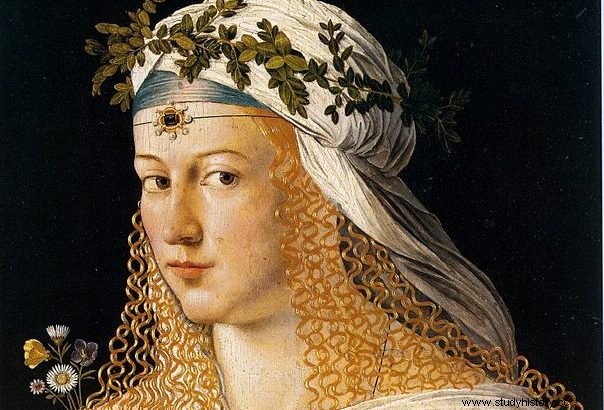
Throughout the centuries of medieval Europe, there was a sharp increase in the number of beauty standards regarding the female body. Many individuals who lived during this time viewed "natural beauty" as God's touch, while those who were considered "ugly" were cursed. Because of the teachings of Greek philosophers such as Aristotle, most people viewed the female body as inferior to a man's. Aristotle assumed that a woman's body became prematurely "cold" during the heat of creation, and mainly categorized a woman as a deformed man. Despite these beliefs, medieval citizens were obsessed with female beauty.
Although the standard of the body was mainly visual, a large part of what made a woman virtuous was their smell. Many factors such as menstrual blood, discharge or simple lack of hygiene can lead to an "unattractive" odor that can drift away more freely. Hoping to create a sweeter, almost floral, scent for the womb, many women considered their scent to show their spiritual and moral character. During this period, many believed that those who were virgins could achieve this standard. Women who did not appear to be considered dirty and unholy, as well as other negative traits.
From the beginning, it was common for women to compare their most lovable qualities with those of a small child. The top standard many women with higher status aimed to achieve was smooth, pure white skin. Many women sought this out, as this would ensure that the audience would be under the assumption that the woman could afford to stay indoors from the wrath of the sun. This will also show a woman's status and their ability to afford not to work one day.
Despite the fact that women were considered to be naturally beautiful beings, many went to extreme lengths to achieve these standards through cosmetic methods. The ideal beauty standard included long, blond hair with curved, dark eyebrows, a small nose, long eyelashes, large bright eyes and small ears. Many women wore large hats, dyed their hair, wore wigs to hide large ears, and used many other methods to become their "highest selves."
In terms of body shape, there were many strangely specific characteristics women strived for throughout this period. Apparently obvious features were full, round hips, smooth thighs, narrow (but modestly covered) breasts and an extremely small waist. The fashions around this time for the upper class, such as waist belts, extremely wide skirts and exotic colored fabric, created an hourglass silhouette many women looked for. More specific features include a "long, small neck", hairless skin color from head to toe and dark red lips.
Diet culture

Even in the Middle Ages, weight was something many people consistently worried about. However, it was the opposite of the concern most people currently have. Instead of worrying about keeping a slim figure, many who wanted to appear with higher status did everything держать weight. This was to show a person (or their family) that they could afford to keep a large amount of food on the table at all times.
Although many tried to achieve this "healthy" look regardless of gender, women were stereotypically the ones who varied in this department. Despite the desire to appear fuller and well-fed, it seemed that a woman's body image changed after giving birth. After this period, it was common for the new mother to see her weight gain as a negative trait, and seek weight loss methods to help them. Because gyms and gyms did not exist, they sought herbs such as fennel and diet-based vegetable tonics such as "Great Monks rhubarb drink" and "Garden's Patience."
The 21st Century
As we move into the 21st century, the concept of the "perfect body" has undergone many major changes since the medieval European era. As the world left the 1990s and entered a new era, the concept of "body positivity" seemed to stand still.
Early 2000s
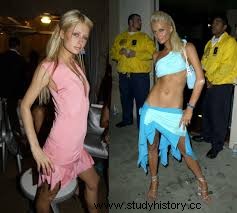
Since the late 1990s, it has become a common encouragement for women to enter a state of mind around independence, success and sexual freedom. Compared to the intense concepts of modesty women have encountered for centuries, this new era created great waves in female society. Despite this development in the behavior of female individuals, the concept of body image has lacked serious positivity.
During this time, Europe and the United States saw a major increase in runway model culture. Top-paying models like Naomi Campbell, Coco Rocha and Natascha Börger were in the spotlight, and girls all over the world idolized them for their talent, looks and, most of all, body type. Soon enough, it became to be slim. Many women sought a slim body type with a small breast, flat stomach and long limbs. Most sought after a dark tan skin color, since the "sexy beach body" was very evident in this era. Other mainstream icons of the time, such as Paris Hilton, were considered the beauty standard of individuals around the world.
A few years after the beginning of the 2000s, another body type took center stage. With celebrities such as Jennifer Lopez, Salma Hayek and Beyoncé growing in popularity, the body image has expanded in the public eye. With this new image, referred to by most as "bootylicious" at the time, individuals began to appreciate the curves, chest and rolls of the body's natural shape. This gave way to several cultures that idolized these functions and counteracted the slim trend.
Many believe it was the male species that had an influence on how girls wanted to look (as in some cases they do), they were also held to incredibly high standards in terms of their own body image. During this period, many men who were naturally tall, had well-groomed full hair and maintained an athletic training regiment were considered the most sought after. Rock stars and "heartbreaking" actors were the image men dreamed of. Men who did not fit this standard were strongly regarded as nerdy, unattractive or even a "loser" in most film portrayals.
"For fat"
Although many viewed these standards as iconic, they resulted in many problems. Many individuals, especially young girls, develop eating disorders and feel the need to eat less and exercise more to reach an "ideal" body type.
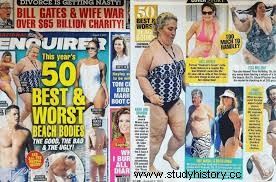
Over the years and until today, many individuals (including the celebrities mentioned) have come forward and discussed how these times were bad for their self-image. Many individuals were praised for reaching a dangerously low weight. Actress and singer Hilary Duff had been in the spotlight since her early teens, and it was when she arrived in her late teens that people criticized her for being "too fat." The criticism was too much to bear. Duff later admitted that she was "obsessed" with everything she ate and only weighed 98 pounds at the age of 17.
Despite the fact that the "bootylicious" body type increased in popularity during this era, a person who was considered "plus-sized" was still kept to a low standard. Women, men and everyone in between with belly, bigger arms and bigger thighs were considered "unattractive" in America and Europe. Although the modeling industry began to employ models that "did not fit the shape", they were not necessarily treated as well as the thinner models.
2010s and beyond
On the way into the 2010s, the body image and its standards made little progress. Curves became more normalized, but only in a more "desirable" form. Celebrities like the infamous Kardashian family became the new ideal. Although it is up to someone to discuss whether these iconic curves and facial features occurred naturally in these women, many individuals began to idolize the appearance of the hourglass figure. During this decade, many have searched for larger breasts, a small waist and a larger than the waist behind. This was achieved by many through the growing popularity of surgery and implants.
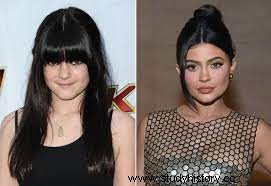
During this period, the world of cosmetics took off at full speed. After many decades of simple, but bold, makeup looks, many began to lean into a "heavier" look. This included coated lips, fuller eyebrows and a fuller foundation. Celebrities like Kylie Jenner were credited with inspiring this trend, and it lasted for much of the 2010s.
In today's Europe and America, many have tried to return to their roots. By today's standards, individuals are beginning to appreciate their natural bodily characteristics. The hourglass shape is as prevalent in women as the athletic one in men. However, body acceptance as we know it is expanding. As exercise routines such as yoga and pilates have taken the lead, many are looking for the "natural look" these days. Although the advertised "body positivity" has come a long way since the 2000s, we still have a long way to go in terms of loving our body when it comes.
Where we are now
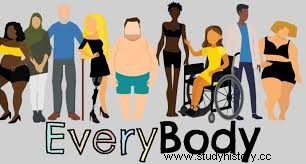
After more than twenty years, in the 2000s, it is obvious that the collective "beauty standard" will always have a form of suffocation in society. There will always be no-sayers who feel they can set the standard for what is considered beautiful and perfect in this world. Despite this, however, the understanding of the body has expanded exponentially.
As the world moves towards the future, it is difficult to say whether we as a species, whether fat, thin, tall, short, pale, dark or what-have-you, will finally accept every body in every form. But if we look at the evolution and change from the "perfect" image of a medieval man, to the beginning of acceptance of all kinds in modern times, it seems that we are moving in the right direction.
